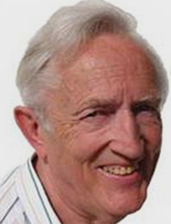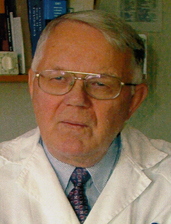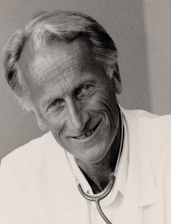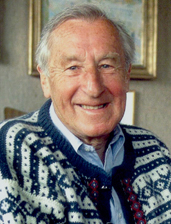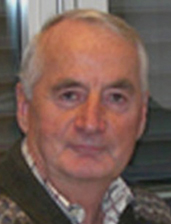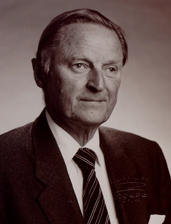Group Interview
Year: October 16th, 2003
Location: Oslo, Norway
Interviewed by: Pyörälä, Kalevi
Abstract
Kalevi Pyörälä (KP) interview with:
Knut Westlund (KW)
Kjell Bjartveit (KB)
Ingvar Hjermann (IH)
Jan Erikssen (JE)
Per Lund-Larsen (PL-L)
Paul Leren (PL)
Kalevi Pyörälä interviews simultaneously six Norwegian pioneers in CVD epidemiology, trials, and screening, in a format that efficiently gets their valuable contributions recorded in summary form. The interview reveals the origins of Norwegian studies in clinical knowledge about familial lipid disorders in a community with a wide interest in nutrition and metabolism and in the post-war transition of health screening from tuberculosis to CVD in that country.
With characteristic Scandinavian modesty, these leaders describe reasons for the outstanding successes (and a few failures) of Norwegian researches and their interactions internally and with overseas efforts, including the International Atherosclerosis Project. (Henry Blackburn)
Quotes
Origins
KP: . . .please, tell me, why and how did you [all] become interested in cardiovascular disease in the Norwegian people?
KW: I’d say that the Oslo City Hospital, Ullevaal in particular, was lucky to have senior physicians who had a certain intuitive grasp on the denominator, the population of Oslo. Oslo City Hospital really was a population-oriented hospital. Even the surgeon, Karl Semb, gave lessons to the general practitioners and tried to teach them some things, and I should name three senior physicians who were pioneers, Carl Müller, of course, then later Anton Jervell and Hans Jacob Ustvedt.
KP: So they really realized that coronary disease was becoming a problem. Before the Second World War, and even after it, tuberculosis was the leading cause of death in the Nordic countries, and the majority of physicians thought that cardiovascular diseases were just problems related to aging and nothing else. But here in Oslo there were some leading physicians who realized that this was not true…….
KW: There were also from the time of the Second World War observations made by well-experienced physicians that there was a decline in mortality from atherosclerotic vascular disease during the war and this was attributed to starvation and reduced intake of fat (Karl Ström and Adelsten Jensen )…… [1]
KP: But there were also reports from the concentration camps that coronary disease disappeared, but such information evidently was not publishable, I think.
PL: Carl Müller wrote about cholesterol, hereditary xanthomatosis and coronary heart disease already in 1939. [2]
KP: Then there was later an important paper by Westlund and Nicolaysen on cholesterol and coronary heart disease mortality. [3]
KW: Ragnar Nicholaysen had several papers before that from the early 1950s, when I think he started to take an interest in lipids. Yes, he was one of the scientists who really initiated a lot of studies.
KP: And then what’s also important was your early interest about the influence of diet on coronary heart disease. Paul Leren’s clinical trial started rather early…..
PL: In ’57. [4]
Beginnings are often simple
KP: Yes, but what did you know, Paul [Leren], at that time?
PL: Well, I didn’t know very much at all. That’s the truth. I had an inspiring chief, Anton Jervell, following Carl Müller as the head of the cardiovascular department, as we called the department. So I didn’t know very much, but I saw every day coronary heart disease and people dying from it. So I was looking for something to do, besides my routine work, and it was Anton Jervell who inspired me to start a controlled trial.
KP: How did you come to the idea of changing dietary fat, like you did? Had you had contact with someone else with similar ideas?
PL: Yes, yes. And I think Kinsell might have been the first one who started looking at cholesterol and diet.
KP: And then there were some people here in the North with interest in diet and coronary heart disease ……..
IH: Haqvin Malmros in Lund…..
PL: Ingvar Hjermann was mentioning studies by Malmros. Of course he was a pioneer and he had to fight someone (Lars Werkö) in Göteborg. That was a hard fight.
PL: He (Lars Werkö) didn’t believe in cholesterol at all.
KP: Yes, but Malmros was really one of the pioneers and then also Turpeinen, Roine and Karvonen who started the so-called Finnish Mental Hospital Study.
PL: So, they were your pioneers.
Population-based studies and intervention trials in Oslo
KP: Then, in Ullevaal Hospital, the next step was to do a big Oslo Study, large screening study, which covered something like 16,000 men. [5] An if I’m correct, Ingvar, your trial (Diet and Antismoking Trial) population [6] was taken was taken from that population study. Then also the trial population of hypertension study which Anders Helgeland was running. [7]
IH: Yes, these trial populations were recruited from the population of the Oslo Study initiated by Leren and Westlund.
KP: What was also important was that you published autopsy findings in people who belonged to that (Oslo Study) population and who later died. [8]
IH: That was the work of one of the many co-workers in that study, Professor Lars Solberg, the Head of the Pathology Unit. He went to the United States, to New Orleans, and took part in the International Atherosclerosis Study.
KP: Then, at the same time or a little bit later (than the Oslo Study), you, Jan, were starting your population study.
JE: Initiated by Ole Storstein (Professor of Medicine at Rikshospitalet, Oslo, pioneer of clinical cardiology in Norway). His idea was, when people die suddenly from coronary heart disease and prove to have extensive disease at autopsy, some of them may have had no symptoms or minor symptoms not mentioned to their doctors and, therefore may have become overlooked. It might be possible to pick up them by doing exercise testing, including exercise ECG. So the study of about 2,000 healthy men from occupational groups in Oslo started. This study (Rikshospital Study) [9] and the bigger Oslo Study were supplementary to each other. In a large study you cannot look at different risk characteristics as closely as it is possible to do in a smaller study in which you can measure a larger number of risk factors.
KP: Ingvar, your [Diet and Antismoking Trial] trial was (among all simultaneously conducted primary prevention trials) the most successful and of course, people often wonder what was the factor that made it so successful. My explanation has been that it was the “Ingvar Hjermann factor”. I believe that when your participants came and saw you, they admired you so much that they didn’t dare to go on without changing their habits……
KW: It was his nurse, his nurse!
IH: So if we’re going to talk a little bit unscientifically about that I should say that it was my dietician, a nice lady from Trøndelag, from Selby. She had great eyes that were very sad, when these people came back and hadn’t done what she had said to them. She had told them to eat less saturated fat and if they hadn’t done that she was so disappointed that they said to themselves: “Next time I will not disappoint her.”
I don’t think we can say much more about that. But the so-called successful diet-smoking trial of the Oslo Study has probably many elements in its success. And one of them, an important one, I suppose, is that Paul Leren told me, when I was planning to do a multi-factorial trial like the MRFIT, Paul Leren said, “Keep the blood pressure outside. Do an extra trial for blood pressure.” And just at that point we didn’t know about the [metabolic] problems [with thiazides] that would appear within the next ten years.
And just to finish, the reason why I succeeded was that I did almost the opposite [of MRFIT]. I did not give any drugs. But I lowered the cholesterol according to Paul Leren’s principles and also aimed at body weight lowering at the same time. So it was some small adjustments of the diet and so when we lowered cholesterol without giving them drugs, we succeeded easily to show significant differences.
PL: The reason why I said: keep blood pressure outside, don’t include that, was that I thought that coronary heart disease must be fought by dietary and hygienic means. Not by tablets.
CVD Mass Screening
KB: What happened was that, on the basis of the experience from tuberculosis screening and its organization and based on the experience from the Oslo Study, a useful system for cardiovascular disease screening could be rapidly developed, an this system was first tried in the most northern part of Norway, in Finnmark. . . . Cardiovascular screening studies were then later expanded to other counties in Norway and over the years covered a huge number of people in Norway. [10] As during the time of its predecessor, the Tuberculosis Screening Service, the results of risk factor measurements carried out by the National Health Screening Service were sent to the general practitioners in the communities and they took the preventive action needed. The data were stored in the computers of the central office of the National Health Screening Service in Oslo and formed the basis of much research on cardiovascular epidemiology in Norway.
PL-L: The National Health Screening Service, including its cardiovascular screening services, has now become combined with the National Public Health Institute, and it is currently not [at] all sure that cardiovascular screening studies will continue. In fact, now it seems that cardiovascular screening studies in their former format will be stopped. What will happen in the future is still not yet fully clear.
References
- Strøm, A. and Jensen, R.A. 1951. Mortality from circulatory disease in Norway 1940-45. Lancet i: 126-9.
- Müller, C. 1939. Angina pectoris in hereditary xanthomatosis. Arch. Intern. Med., 64: 675-700.
- Westlund, K. and Nicolaysen R. 1966. Serum cholesterol and risk of mortality and morbidity. A 3-year follow-up of 6,886 men. Scand. J. Clin. Lab. Invest., 87 (Suppl.): 1-19.
- Leren, P. 1966. The effect of plasma cholesterol lowering diet in male survivors of myocardial infarction. Acta Med. Scand., 466 (Suppl.): 1-92.
- Leren, P., Askevold, E.M., Foss, G.P., Froili, A., Grymyr, D., Helgeland, A., Hjermann, I., Holme, I., Lund-Larsen, P.G., and Norum, K.R. 1975. Cardiovascular disease in middle-aged and young Oslo men. Acta Med. Scand., 588 (Suppl.): 1-38.
- Hjermann, I., Velve Byre, K., Holme, I., and Leren, P. 1981. Effect of diet and smoking intervention on the incidence of coronary heart disease. Report from the Oslo Study Group of a randomized trial in healthy men. Lancet, ii: 1303-10.
- Helgeland, A. 1980. Treatment of mild hypertension: A five year controlled trial. The Oslo Study. Am. J. Med. 69: 725-32.
- Solberg, L.A., Strong, J.P., Holme, I., Helgeland, A., Hjermann, I., Leren, P., and Mogensen, S.B. 1985. Stenoses in the coronary arteries. Relation to atherosclerotic lesions, coronary heart disease, and risk factors. The Oslo Study.Lab. Invest. 53: 648-55.
- Erikssen, J. and Enger, S.C. 1978. Smoking, lung function, physical performance and latent coronary heart disease in presumably healthy middle-aged men. Acta Med. Scand. 203: 509-16.
- Bjartveit, K., Foss, O.P., Gjervik, T., and Lund-Larsen, P.G. 1979. The Cardiovascular Disease Study in Norwegian Countries. Acta Med. Scand., 634 (Suppl.): 1-70.
Full Transcript Access
Full transcripts of interviews may be made available to those engaged with original materials for scholarly studies by contacting us.
